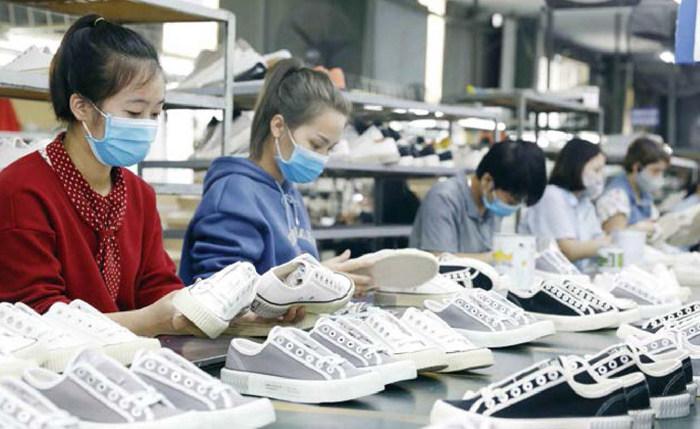越南对RCEP寄予厚望
2022-03-14《美国之声新闻》社论
《美国之声新闻》社论

越南有可能在《區域全面经济伙伴关系协定》(RCEP)生效之初就有所收获。澳大利亚和新西兰在2021年11月2日核准了该协定,使之达到了生效的标准。协定已于2022年1月生效。
一共15个亚太地区的国家联合签署了RCEP,即中国、韩国、日本、澳大利亚、新西兰五国,加上东盟的文莱、柬埔寨、印度尼西亚、老挝、马来西亚、缅甸、菲律宾、新加坡、泰国和越南10国。
RCEP是公认的世界最大自贸协定,囊括了全球约30%的人口以及世界约30%的GDP。协议将为区域内90%的商品削减关税。
越南认为RCEP是其融入世界经济的成果之一,这一点在新冠肺炎疫情肆虐以及世界经济亟待复苏的当下显得尤为突出。越南另有14个早已生效的自贸协定,这些协定加上RCEP,能让越南的出口产品以更低的关税进入更大的市场。
麦克拉迪投资咨询公司的地缘战略高级顾问史蒂文·奥肯表示,RCEP意义重大,尤其是在简化贸易流程和加快整合供应链等方面。
“长期来看,如果RCEP让中国—东盟、日本、韩国之间的贸易关系更为紧密,这将影响美国融入该地区经济体系,但是也为如越南等东南亚国家带来更多机会。但这可能不会影响中国当前的供应链转移。”史蒂文说。
更廉价的进口商品
对越南来说,RCEP也会为更廉价的生产原材料进口铺平道路。越南光是在东盟内的原材料和生产设备的年进口额就达到了300亿美元。此外,越南贸易投资部的官方报纸表示,越南对中国和韩国等大型市场有着每年几百亿美元的贸易逆差。
从RCEP成员国进口的原材料在越南加工生产后,出口至其他RCEP国家时,这些原材料将被视作越南原产材料,这使得出口产品可以全部打上“越南制造”的标签,在进口国享受更低的关税。这些进口国往往也是电子产品、零部件、纺织、制鞋等越南强势产业的原料出口国,而这些越南产业每年出口额达数百亿美元。
“所以,只要越南能为大多数RCEP成员提供所需的优质农业、渔业产品,就能从RCEP中获益。由于RCEP内优秀的原产地规则,越南货物很容易达到关税削减标准,从而增加越南在RCEP内的出口,尤其是面向日本、韩国、澳大利亚、新西兰的出口。”越南贸易投资部的官方报纸表示。
越南皮革、鞋类和手提包协会副会长潘氏成春表示,协会的代表产业将利用RCEP协定的优势,降低从中国进口原材料的成本,从而获益。虽然越南早已通过中国—东盟自由贸易协定,从中国进口大量原材料,但越南产品在出口到中国或东盟以外的其他国家时,由于原产地规则问题,不会被当成越南原产。在RCEP框架下,同样的出口则会被当做越南原产,从而在出口到如日本之类的除东盟外RCEP国家时享受到更低的关税。
对越南国内市场的影响
对越南来说,加入RCEP有利有弊。虽然加入RCEP后越南出口有着良好的增长前景,能带动越南经济增长,但也有人担心RCEP对越南国内市场的影响。越南98%的企业都属于中小企业,它们的产品会与其他RCEP产品竞争。
以制鞋业为例,潘氏成春认为中小企业必须提升竞争力:“(它们)核心竞争力很弱,在现在这个竞争激烈的市场中,不进步就只能灭亡。”
“现实就是,中小企业在行业中(制鞋业)占60%,但它们对出口的贡献很低,只有不到20%。相较而言,越南的外资企业和本土大公司只占行业的30%~40%,但它们的出口量占了80%~90%之多。”潘氏成春说。
“但这也算某种优势,能鼓励越南提升产能。越南在制鞋业有着许多独特优势,也是世界第二大鞋类出口国。我们与全球主要市场都建立了长期稳定的供应链,越南的外资企业绝大部分也是长期投资。”潘氏成春说道。
她还说:“总体而言,越南制鞋业的增长潜力依然优秀,保持着一定的竞争力,越南在大品牌之间的声誉也很好,它们还在提供源源不断的订单,外资也在持续投入越南制造业,至少10~20年内不会改变。”
新加坡美国商会前董事欧坤表示,越南跟大部分RCEP国家比起来有一大优势,那就是越南签署了另一项贸易协定——《全面与进步跨太平洋伙伴关系协定》(CPTPP)。
欧坤说:“CPTPP也包含高质量的数字贸易规定,如果得到全面实行,能进一步强化越南的数字经济,并带来更多数字经济领域的机遇,使其成为越南的下一个经济增长点。”
“越南应该尽快履行其在CPTPP内的承诺,并与新加坡等重要伙伴签订新的数字贸易协定,不要满足于现有协定。同时从RCEP和CPTPP中受益能让越南在为经济复苏打基础时保持自身的优势地位,使数字经济带来的机遇最大化。”欧坤说道。
·来源:美国之声
·编译:谢宗鸣
In what was expected to be an uphill battle, Vietnams containment of the COVID-19 crisis has left little time for recognition on the world stage. While decisive central government response successfully beat back the pandemics viral challenges, authorities are now facing the real and present dangers of climate change. The moment provides an opportunity and imperative to explore renewable energy for less carbon-intensive growth.
The nation knows all too well, that it is among the most vulnerable nations to climate change impacts. From Vietnams long coastline along the East Sea, to landslides in the northern mountains, to rising sea levels in the Mekong Delta, the nations extreme weather events are taking their toll.
“The Earths recent calamities have placed great burdens on the political and socioeconomic life of many developing countries, causing unemployment and poverty, creating instability and exacerbating current conflicts”, said Nguyen Xuan Phuc, President of Vietnam in a United Nations (UN) speech via webinar.
Vietnam recognizes the urgency in supporting the 2030 Agenda for Sustainable Development, the UN Framework Convention on Climate Change (UNFCCC), and the Paris Agreement (COP21).
The World Bank has singled out Vietnam as one of six countries most severely affected by climate change. As such, Vietnam is at a tipping point as it ramps up its ability to meet its energy needs and reduces its reliance on coal-fired power generation.
Vietnams death toll from the pandemic has remained low. In contrast, the nations rising air pollution levels and severe tropical storms have resulted in increased hospitalisations and deaths.
Climate Risks
A 2019 INFORM Risk Index, a global, open-source risk assessment for humanitarian crises and disasters, ranked Vietnam 91 out of 191 countries largely because of the countrys super strong typhoons, storm surges, riverine flooding, coastal erosion, drought and salt water intrusion.
The ocean level has already risen 20 centimetres over the past three decades and may increase by a further 75 centimetres by 2050. This will lead to a flooding of 40% of the rice bowl in the Mekong Delta.
Policy makers are asking themselves what steps or lessons they can apply from their successful combat against COVID-19 toward the climate associated risks. Just as authorities called for a community wide compliance with the closing of borders, masking, and social distancing; the ingrained collectivism among its citizens, allows for a broad and clear messaging about the environmental threats. This may translate into improved management of the nations natural resources.
Few experts dispute that raising the awareness levels of Vietnamese people can and will insure sustainable development of the country. However, available information about the countrys climate situation is limited, unstructured and difficult for the major population to access and understand.
Credit should be given to Vietnams newest eAtlas project. A team of research scientists are making available a series of atlases of the nations climate conditions using multiple images and sources derived from satellites.
“The atlases consist of a number of principal environmental variables including surface temperature, humidity, wind, vegetation index, sea level, ocean current, and waves,” claims Dr Nguyen Dac Da, a post-doctoral oceanography researcher at the University of Miamis Rosenstiel School of Marine and Atmospheric Science.
His team of five, comprised of other oceanographers, a meteorologist and IT expert, is now building a ‘wire grid to deliver climate change views through graphical tools to every corner of the country. Of course, Nguyen admits that collaborations are essential to achieve this goal.
Less Coal, More Renewables
During the pandemic, Vietnamese authorities quickly discovered that social media can be adopted for value-added science related campaigns. The governments next transition step may include the promotion of greener habits and green technology. Simply put, a green economy offers lower carbon use, saves resources, creates jobs, eradicates hunger and reduces environmental risks.
With a population approaching 100 million and annual gross domestic product (GDP) growth expected to rebound to seven percent, Vietnams power generation needs rose from 47,000 megawatts (MW) to over 60,000 MW in 2021 and 129,500 MW by 2030.
Unfortunately, Vietnams consumption of coal continues to rise and grew 75% over the past six years, faster than any country in the world, according to a research paper by the Harvard Kennedy Schools Ash Center on Vietnam. In fact, its coal imports surged in the first half of 2020 to fuel the number of coal-fired power plants.
The nations fast-growing economy has come with major environmental consequences. The fast pace of urbanization, on-going construction, heavy vehicular traffic and industrial production activities, are leaving urban areas like Hanoi and Ho Chi Minh City, gasping for air and suffering high levels of respiratory disease.
The crossroads between economic development and environmental protection has resulted in citizen-led vigilance of the countrys conservation and sustainability practices. Climatologists and environmentalists are slowly succeeding in heightening awareness of a green recovery, that is leading to accountability, the mitigation of climate change and the monitoring of industrial pollution.
It helps that the government has issued new policies to encourage the development of renewable energy, set targets for renewable energy and provided production research for eco-driven pilot models, like solar and wind development.
Vietnam knows that it must take the same bold action that was initiated to curb the transmission of COVID-19. Policy planners realise the country has large untapped renewable energy potential for solar and wind.
The adoption of these renewables offers a cleaner environment and puts the country in line to meet its Paris Agreement targets. Should government policy continue to support renewables while making wind and solar better and cheaper, these renewable energy sources can challenge coal as Vietnams biggest electricity source by 2030.
With the world under pressure to set tougher climate targets and the holding of critical climate change talks in November 2021 at the United Nations Climate Change Conference (COP26) in Glasgow, its another opportunity for Vietnam to showcase its leadership in Southeast Asia in its fight to overcome the impacts of future pandemics and climate change.
· Source: The ASEAN Post
